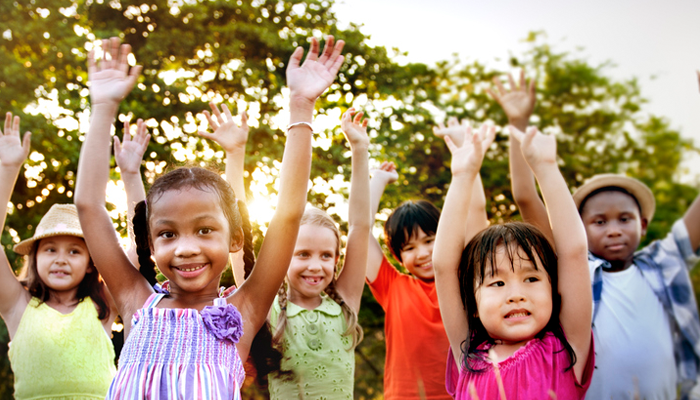Like many adoptive parents, my husband and I take our agency’s advice to celebrate our daughters Guatemalan heritage seriously. Huipils and animal masks decorate our walls. We speak Spanish — or try to — with our Guatemalan babysitter. We seek out Latin music concerts and spend a week every August at La Semana, a Latin-American culture camp.
Our enthusiasm is heartfelt. But I’ll admit that I often can’t shake the feeling that were tourists, click, click, clicking away with our cameras. The culture Walter and I know from the inside, after all, is the one our children breathe every time they turn on the TV, slurp their cereal, and play baseball at the park.
Whether or not adoptive parents can effectively interpret another culture to their foreign-born children is a subject that’s getting a lot of attention from adoption experts these days. Some would like to see changes in the way our kids learn about birth cultures. Others think it’s time to flip the equation entirely. Learning about a birth culture, they say, is fine. But it should take a back seat to explorations of what it means to be adopted and what it’s like to grow up in a society that still prizes whiteness. “Our children’s primary concern isn’t, ‘Who would I have been had I grown up in my birth culture?'” says adoptive mother and adoption educator Jane Brown. “It’s ‘Who can I be?'”
Since most adoptive parents are white and were born into our families, we may feel at a loss when we try to help our kids navigate what is, to us, uncharted territory. Brown’s advice is simple: “Make it happen.” Here are ways to do that.
Focus on race and adoption
Unlike many camps geared specifically to adoptees, Holt International Adoptee Camp has no culture component. Instead, it focuses on the identity development of international, transracial adoptees. “We talk about what it means to have conflicting feelings, what it means to be an adoptee, what its like to be a person of color in a white family, how to talk with their friends if they make insensitive remarks,” says Steve Kalb, the camp’s director (who is a Korean adoptee). While these sessions are the camp’s defining purpose, they constitute only a small portion of its five-day-long, sleepaway experience. Most of the campers’ time is spent making friends and doing everything a traditional overnight camp offers — marshmallow roasts, flashlight tag, boating, stargazing. Many campers find it a transforming experience. “One kid said that it felt like home, because he didn’t have to worry about people judging him,” says Kalb.
Some culture camps, too, are beginning to explore such issues. For Susan Stokes, the most important experience of her daughter Bella’s first year at La Semana was the Play-Doh exercise. “It was based on the idea that no one is truly black or white,” says Stokes. “The kids kneaded white modeling clay with strawberry- and chocolate-flavored milk powder to create a color that matched their skin tone. Then they came up with names for their different shades. Bella came home and showed me her Play-Doh. She said, This is me! I’m caramel!”
Because camps like Holt and La Semana have counselors and instructors who were either adopted themselves or are from the campers’ birth cultures, they provide kids with opportunities to make connections with mentors who share their heritage — not to mention connections with each other. “There’s a generation of adoptees who grew up going to camps,” says Korean adoptee and adoption researcher Kim Park Nelson. “The community that can develop from camp is critical.”
Adoption Workshops 101
How to know if your child is ready to explore feelings about birth family and adoption in a group setting? Psychologist Rebecca Nelson suggests the following:
- If your child is asking questions such as “Why was I adopted?” or “Why couldn’t my birth parents keep me?” he’s probably ready.
- Introduce the idea to your child and provide information about the workshop. Let her know that you want her input.
- If your child resists the idea, try to understand why. In the end, trust your instinct. You’ll know if it’s right for your child.
- Don’t reject the workshop idea, even if your child never inquires about adoption. In fact, some children would rather open up with peers who were adopted.
- Finally, research the workshop you’re considering. Make sure your feelings are in line with the workshops philosophy by asking:
What are the facilitators training and experience?
How old are the kids?
Will the group be co-ed?
Whats the main focus of the workshop — birth parents, self-esteem, race?
What happens if my child doesn’t want to participate in workshop activities? How do you respond?
If we have questions after the workshop, is there someone to follow up with?
Camps aren’t the only way to explore how kids fit into their ethnic community and how to live as hyphenated Americans. Many adoption agencies and parenting organizations sponsor workshops on adoption. In her series of adoption playshops, held across the country, Brown works with teams of adult adoptees, using crafts, puppets, and non-competitive games to help kids talk about anything from birth parents to getting teased. “It’s a relief for these kids to learn that other children are like them,” says Brown. “It’s like, Wow! I’m normal.” Brown’s workshops include a mandatory parent session. “You can’t open up issues for children without having support from their parents,” she explains.
No matter which options you choose, experts stress that a week at camp or a weekend workshop can’t be the beginning, middle, and end of your child’s adoption education. Seeing teachers, doctors, and family friends who aren’t white, as a part of everyday life, is essential. “It’s not like race happens once a year,” says the Evan B. Donaldson Adoption Institutes Hollee McGinnis, who was adopted from Korea.
Modernize our understanding of culture
Culture camps became a fixture of the adoptee experience in the 1980s and 1990s. They were started by adoptive parents and agencies, who developed the curricula at the request of older adoptees who said they would have benefited from knowing more about the countries where they were born. It’s an idea that makes sense, at least in theory. When adoptees move away from home, they find that people expect them to be experts on their birth countries.
Yet when the Adoption Institute surveyed more than 400 adult adoptees about the experiences that helped them form healthy identities, culture camps ranked surprisingly low — below reading articles online and having mentors of the same race. Those results make sense to social worker and Korean adoptee Deborah Johnson, who is the director of Kindred Journeys, a heritage travel company in Minneapolis. She sees culture camps as a great starting point. But “the reality is that we aren’t raising our children to be Chinese in China,” she explains. “We can’t raise them to be bicultural, because cultures in other countries are evolving just as fast as American culture is.”
Emphasis on traditional folk culture instead of contemporary life in Bogota or Seoul or Beijing concerns adoption experts like Park Nelson, who developed and taught the first-ever course in Korean adoption studies, at the University of Minnesota. “Knowing how to do the fan dance doesn’t give you any cultural cache in Korea,” she says. “Korea is one of the most electronically and technologically advanced societies in the world. Korean pop culture — music, film, fashion — is sweeping the world.”
Traveling is another way to broaden our families horizons and help our children learn to value differences. When Laura and Chris Pardo took their children to Antigua, their daughter Mia, then seven, knew that this country was special to her. As they walked down the street, Mia looked up at her mother and smiled. “These are my people,” she said. Other families make a point of routinely visiting large American cities to spend time in Chinatowns, Koreatowns, or other ethnic neighborhoods.
Step back
Sometimes the most important lesson a parent can learn is when to get out of their kids’ way. That’s what Steve Kalb has found at Holt Adoptee Camp. He says, “Many adoptees worry that they will hurt their parents by talking about these issues, so there is freedom that comes with being away from their parents.”
Parents have to realize that we can’t personally meet all of our children’s needs. But, Johnson counsels, we can admit that, while we don’t know what it feels like to experience racism, or to be adopted, we can get angry because they are angry. We can find ways to get them the support they need and deserve.
That challenge faced adoptive mom Lynette Lamb, when she was looking for babysitters for her daughters Grace, 11, and Julia, seven, who were adopted from China. She decided to place an ad in the University of Minnesota newspaper. The girls now have close relationships with two babysitters who were adopted from Korea, and who talk with them about what it’s like to be adopted.
Experts say this kind of mentoring is crucial for children who were adopted internationally. Soon after enrolling her daughter in a Spanish immersion school, with primarily Latino teachers, Stokes noticed that Bella started talking about wanting to be a teacher herself.
Accept the fact that you may be uneasy
Providing cultural experiences for our children means that we will sometimes be in situations where we don’t fit in. “On homeland trips, parents sometimes talk about feeling uncomfortable when people stare at them,” says Johnson. “And I say, isn’t that great? You get a view of what everyday life is like for your child.”
It’s this allowing ourselves to be uneasy that both Brown and Johnson say is the most challenging and most important part of parenting a child of a different race. “Adoptive parents often don’t know whether or not they will be included in multicultural programs or gatherings,” says Johnson. “But why not? That’s who you are. It helps to change the focus from ‘Where am I going to fit in?’ to ‘Where is my kid going to fit in?'”



